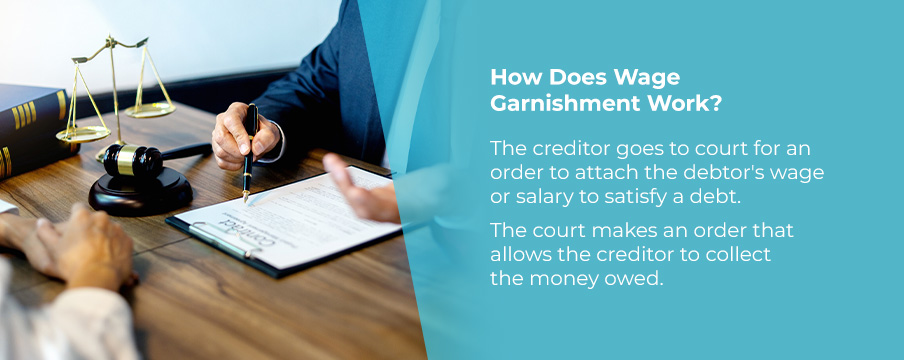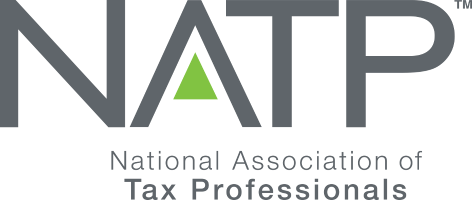If you’ve received a wage garnishment order and are wondering what to do, you’ve come to the right place. In terms of taxes, wage garnishment allows the IRS to take money directly from your hard-earned salary to pay tax debts, which can leave you financially stranded for years. While the agency can proceed against your wage, the law also offers several protections and remedies to help you meet your tax obligations. Partnering with a reliable tax consultant is recommended since they can help you reduce your tax debts and make informed decisions.
What Is the Meaning of Wage Garnishment?
Wage garnishment means deducting money from an employee’s wages or monetary compensation under an order from the court or state agency in satisfaction of a debt. In other words, wage garnishment occurs when a creditor obtains an order to allow them to collect debts through the debtor’s wages.
Typically, the court or government agency directs the debtor’s employer to pay the debt according to the directions given in the order. Wage garnishment laws allow creditors to collect monies due to them with state backing, but they also protect debtors by providing safeguards that employers and creditors must follow.
Garnishment is typically a percentage of the employee’s compensation instead of a set amount. Federal and state laws provide guidelines for the maximum earnings that can be garnished. Generally, the employer receives a notice from the court or government agency, which compels them to calculate and withhold the percentage and submit it to the creditor as directed. Failure to comply with the order can result in legal sanctions.
The IRS employs wage garnishment to collect tax debts through paychecks. However, unlike other creditors, the IRS may not require a court order or judgment before garnishing your wages, although they must follow established guidelines. We cover exactly how that works below.
Other Types of Garnishment
The IRS can also employ non-wage garnishment to satisfy tax debts. In this case, the individual’s bank account is attached to satisfy a debt owed.
While not technically garnishment, another option is “voluntary wage assignment.” In this situation, the employee willingly agrees with a creditor to pay a debt owed with a portion of their salary or wages. Although the employer pays the creditors a part of the employee’s salary, they do so at the employee’s request rather than due to a court or government order.
How Does Wage Garnishment Work?
Typically, the creditor goes to court for an order to attach the debtor’s wage or salary to satisfy a debt. The creditor must demonstrate that the debtor owes a debt or a legal obligation, the performance of which has become due. When successful, the court makes an order that allows the creditor to collect the money owed.

The process is different when it comes to tax debts. The IRS may garnish your salary without a court order, although they must follow established procedures. Before taking any collection action, the IRS must notify the taxpayer of the tax liability. The warning will typically state the balance due and advise the individual to make payment. If they fail to reply to the warning or pay the stipulated amount, the IRS may issue an LT 11 notice or Letter 1058.
The LT 11 notice or Letter 1058 informs you that the IRS plans to take collection actions like a levy or lien on your wage or bank balances unless you pay the balance due. If you receive a letter that says “Final Notice of Intent to Levy and Notice of Your Rights to a Hearing” or something of that nature, it’ll help to respond quickly, usually within 30 days. The response could be to pay the debt or request a hearing.
Usually, both the employer and the employee receive a notice alerting them of the order and instructing the employer on how to execute it. The notice may also contain contact information if the employer or employer needs assistance.
How Does Wage Garnishment Affect You?
Here are three ways wage garnishment can affect you:
1. Finances
Wage garnishment can affect your finances far into the future if the order remains in force. As explained, garnishment is an order that reduces a person’s income, causing additional burdens for an already struggling debtor. The debtor may encounter challenges securing basic needs, especially when they have dependants. If not properly managed, the impact can affect other members of the household or various aspects of the individual’s livelihood.
2. Credit Score
In 2017, the three credit bureaus — Experian, Equifax and TransUnion — exempted tax liens and civil judgments as public records entered in credit reports. This means wage garnishment orders have no direct impact on your credit score. However, they can still affect your creditworthiness. Creditors still report delinquent debt, including tax liabilities, to the reporting agencies. They can also add information about the debt collection process, including garnishment.
Payment history is essential in most credit scoring formulas, so a series of missed payments culminating in wage garnishment can impact your scores. Negative information remains on your credit history for seven years, affecting your ability to qualify for more credit.
3. Reputation
The impact of wage garnishment goes beyond paychecks. Most employees find garnishment processes disturbing, considering that the court has to intervene and employers are dragged into their otherwise private challenges. The individual’s reputation may be affected, especially when the liability is left unresolved for a long duration. So it helps to take swift action to get the situation under control.
When Can Wage Garnishment Be Obtained?
Wage garnishment may be obtained in many instances, including the following:
- Unpaid taxes: The IRS may pursue wage garnishment when your tax liabilities remain unsettled for a long time. The amount payable depends on several factors, such as your disposable income and number of dependents.
- Consumer debts: Debtors may access unsecured credit through personal loans or credit cards. When they fall behind on those debt payments, the creditor may obtain a wage garnishment and attach their salary to pay for the loan.
- Child support: The court can order a parent’s employer to deduct the employee’s salary for child support. This is usually when the parent is in arrears or is known to be delinquent on other debts. According to the federal Office of Child Support Services, aspects of the income that can be withheld include wages, salaries, bonuses, commissions and pensions.
- Student loan debt: Defaulting on federal student loans can cause lenders to require employers to garnish your wages. The deductions may continue until the debts are fully paid or the default status is resolved. Wage garnishment arising from a default on federal student loans may also commence without a court order.
What Happens After Wage Garnishment Is Ordered?
The employer and employee typically receive notices from the court or state agency issuing the order. Depending on where the order originates, it may be called a writ of garnishment, a tax levy or an income withholding order. The notice may include instructions on how the employer should execute the wage garnishment order. Some orders may require the employer to submit certain documents within a specified period. Otherwise, the employer may proceed to withhold cash straightaway unless so ordered.
After deducting and withholding the amount, the employer will send it to the creditor indicated in the notice. It’s vital to learn about any reporting requirements and comply with them. Where you cease to work for the notified employer, they will advise the appropriate authority. The garnishing will continue until the terms stated in the order have been fulfilled or the issuing authority informs the employer to stop.
It’s best to partner with a professional whenever you receive a wage garnishment order. Their experiences may be crucial in determining your next action.
Are There Limitations on the Amount That Can Be Garnished?
Federal and state laws limit the amount the creditor may garnish from the debtor’s wage. The garnishment amount is based on the employee’s disposable earnings. Disposable earnings are the income left after legal deductions. Examples of such legal deductions include state and federal taxes, social security payments, state unemployment insurance taxes and withholdings from employee retirement plans required by law.

Excluded legal deductions, including union dues, health and life insurance voluntary, purchases of savings, contributions to charitable causes and retirement plan contributions, unless required by law, are typically added to gross earnings when computing disposable earnings under the Consumer Credit Protection Act (CCPA). Title III of the CCPA provides the maximum amount creditors may garnish in any pay period or workweek, regardless of the number of garnishment orders the employer receives. Here are some examples:
- Consumer debt: A maximum of 25% of the disposable income or the amount by which the disposable income exceeds 30 times the federal minimum wage, whichever is lower.
- Child support: A maximum of 50% of the debtor’s disposable earnings may be deducted if they support a child or spouse. Otherwise, a maximum of 60% may be deducted. A further 5% may be deducted if the support payments have been in arrears for over 12 weeks.
Other laws provide added information about the maximum amounts that can be garnished. For example, according to the Higher Education Act (HEA) of 2018, the Department of Education can garnish 15% of the debtor’s disposable income for unpaid student loan debt. Besides the federal limitations, state laws may also restrict the wage garnishment amounts.
For example, in Colorado, creditors and debtors collectors can garnish 20% of your disposable weekly income or the amount exceeding 40 times the state or federal minimum wage. Currently, the state’s minimum wage stands at $13.65.
It’s also important to note that these limitations do not apply to the IRS. The IRS determines the amount to be garnished based on standard deductions, your filing status and the number of dependants the debtor has claimed. The garnishment could be a higher percentage of the disposable earning depending on the income and debt. If you have multiple income sources, the IRS may assign the exemptions to which you are entitled to those income sources and possibly levy 100% of the earning from a specific employer.
How Can You Get a Release on an IRS Levy?

Here are four ways to get a garnishment order released:
1. File for an Offer in Compromise
An offer in compromise (OIC) enables debtors to settle tax liabilities owed to the IRS, usually for less than the total amount owed. Getting a tax settlement is not automatic. You may obtain a tax settlement when you demonstrate that:
- There is a genuine reason to question the accuracy of the amount determined by the IRS.
- Your income and assets are less than what you owe, resulting in a doubt that the debt is fully collectible.
- The amount determined by the IRS is correct. However, you cannot pay without facing economic hardship, or it would be unfair and inequitable due to exceptional circumstances.
You can make an offer by completing Form 656 and submitting it to the IRS. The IRS will assess your eligibility by considering factors such as anticipated future income, the value of your assets and your future situation after filling out Form 433-A to determine an accurate offer.
The IRS has a pre-qualifier tool you can use to measure your eligibility for an OIC. You can increase your chances of getting tax settlement by:
- Filing current tax returns to provide the IRS with updated financial information.
- Promptly submitting all payroll taxes if you own a business with employees.
- Paying the required fees promptly.
- Waiting to declare bankruptcy until you go through the OIC process.
If the IRS accepts your OIC, you must comply with the terms provided in the agreement. Breaching the agreement may cause the IRS to bring legal action against you for the original amount plus interest and penalties.
2. Enter Into an Installment Agreement
The IRS offers installment payment plans designed to enable you to pay back taxes over an extended duration. You may apply for a short-term or long-term payment agreement plan. The short-term plan gives you up to 180 days to pay your debts, while the long-term plan, also known as an installment agreement, allows you to spread out your payment through monthly installments.
3. Apply for Noncollectible Tax Status
Taxpayers who can’t afford to pay back taxes may request a currently not collectible (CNC) status. Securing a CNC status suspends the IRS’s aggressive tax efforts, such as garnishing your wages and placing levies and tax liens. However, the debt remains and continues to accumulate interest and penalties. CNC status only provides temporary tax relief. Therefore, the IRS may resume its collection efforts when your financial situation improves.
4. Challenge the Levy
You may challenge the IRS by filing an appeal or suing in court if you believe you have no outstanding debts. You can also request an audit reconsideration if your tax liability was miscalculated. Another way to challenge an IRS levy is by demonstrating that the statute of limitation has passed, barring the IRS from proceeding against you.
Contact BC Tax Today!
The complexities of the above are what we do best. BC Tax is a tax consultation agency with years of experience helping clients reduce tax debts and stress. Our licensed enrolled agents will dedicate time and effort to listen to your concerns and provide solutions to your tax challenges. Receiving a wage garnishment order is not the end of the world. Contact us now for professional assistance!

 1-800-548-4639
1-800-548-4639









